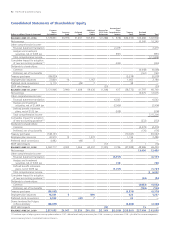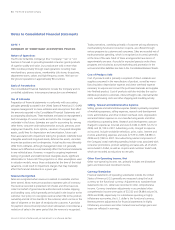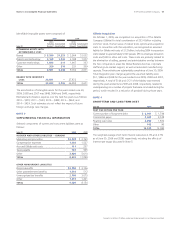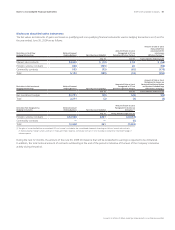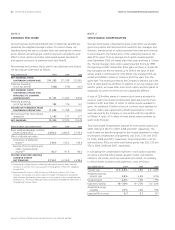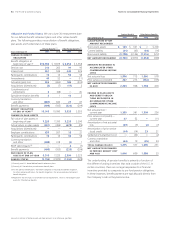Proctor and Gamble 2009 Annual Report Download - page 61
Download and view the complete annual report
Please find page 61 of the 2009 Proctor and Gamble annual report below. You can navigate through the pages in the report by either clicking on the pages listed below, or by using the keyword search tool below to find specific information within the annual report.Notes to Consolidated Financial Statements The Procter & Gamble Company 59
Amounts in millions of dollars except per share amounts or as otherwise specified.
Interest Rate Risk Management
Our policy is to manage interest cost using a mixture of fixed-rate
and variable-rate debt. To manage this risk in a cost-efficient manner,
we enter into interest rate swaps in which we agree to exchange with
the counterparty, at specified intervals, the difference between fixed
and variable interest amounts calculated by reference to an agreed-
upon notional amount.
Interest rate swaps that meet specific accounting criteria are
accounted for as fair value and cash flow hedges. There were no fair
value hedging instruments at June30,2009 or June30,2008. For
cash flow hedges, the effective portion of the changes in fair value of
the hedging instrument is reported in other comprehensive income
(OCI) and reclassified into interest expense over the life of the under-
lying debt. The ineffective portion, which is not material for any year
presented, is immediately recognized in earnings.
Foreign Currency Risk Management
We manufacture and sell our products in a number of countries
throughout the world and, as a result, are exposed to movements in
foreign currency exchange rates. The purpose of our foreign currency
hedging program is to manage the volatility associated with short-
term changes in exchange rates.
To manage this exchange rate risk, we have historically utilized a
combination of forward contracts, options and currency swaps. As
of June30,2009, we had currency swaps with maturities up to five
years, which are intended to offset the effect of exchange rate
fluctuations on intercompany loans denominated in foreign currencies
and are therefore accounted for as cash flow hedges. The Company
has also utilized forward contracts and options to offset the effect of
exchange rate fluctuations on forecasted sales, inventory purchases
and intercompany royalties denominated in foreign currencies. The
effective portion of the changes in fair value of these instruments is
reported in OCI and reclassified into earnings in the same financial
statement line item and in the same period or periods during which
the related hedged transactions affect earnings. The ineffective
portion, which is not material for any year presented, is immediately
recognized in earnings.
The change in value of certain non-qualifying instruments used to
manage foreign exchange exposure of intercompany financing
transactions, income from international operations and other balance
sheet items subject to revaluation is immediately recognized in
earnings, substantially offsetting the foreign currency mark-to-market
impact of the related exposure. The net earnings impact of such
instruments was a $1,047 loss in 2009 and gains of $1,397 and $56
in 2008 and 2007, respectively.
Net Investment Hedging
We hedge certain net investment positions in major foreign subsidiaries.
To accomplish this, we either borrow directly in foreign currencies
and designate all or a portion of foreign currency debt as a hedge of
the applicable net investment position or enter into foreign currency
swaps that are designated as hedges of our related foreign net
investments. Changes in the fair value of these instruments are imme-
diately recognized in OCI to offset the change in the value of the net
investment being hedged. Currency effects of these hedges reflected
in OCI were an after-tax gain of $964 in 2009 and $2,951 loss in 2008.
Accumulated net balances were a $4,059 and a $5,023 after-tax loss
as of June30,2009 and 2008, respectively.
Commodity Risk Management
Certain raw materials used in our products or production processes
are subject to price volatility caused by weather, supply conditions,
political and economic variables and other unpredictable factors.
To manage the volatility related to anticipated purchases of certain of
these materials, we use futures and options with maturities generally
less than one year and swap contracts with maturities up to five years.
These market instruments generally are designated as cash flow
hedges. The effective portion of the changes in fair value for these
instruments is reported in OCI and reclassified into earnings in the
same financial statement line item and in the same period or periods
during which the hedged transactions affect earnings. The ineffective
and non-qualifying portions, which are not material for any year
presented, are immediately recognized in earnings.
Insurance
We self insure for most insurable risks. In addition, we purchase insur-
ance for Directors and Officers Liability and certain other coverage in
situations where it is required by law, by contract, or deemed to be in
the interest of the Company.
Fair Value Hierarchy
New accounting guidance on fair value measurements for certain
financial assets and liabilities requires that assets and liabilities carried
at fair value be classified and disclosed in one of the following three
categories:
Level 1: Quoted market prices in active markets for identical assets
or liabilities.
Level 2: Observable market-based inputs or unobservable inputs
that are corroborated by market data.
Level 3: Unobservable inputs reflecting the reporting entity’s own
assumptions or external inputs from inactive markets.
In valuing assets and liabilities, we are required to maximize the use
of quoted market prices and minimize the useof unobservable inputs.
We calculate the fair value of our Level 1 and Level 2 instruments
based on the exchange traded price of similar or identical instruments
where available or based on other observable instruments. The fair
value of our Level 3 instruments is calculated as the net present value
of expected cash flows based on externally provided inputs. These
calculations take into consideration the credit risk of both the Company
and our counterparties. The Company has not changed its valuation
techniques in measuring the fair value of any financial assets and
liabilities during the period.





